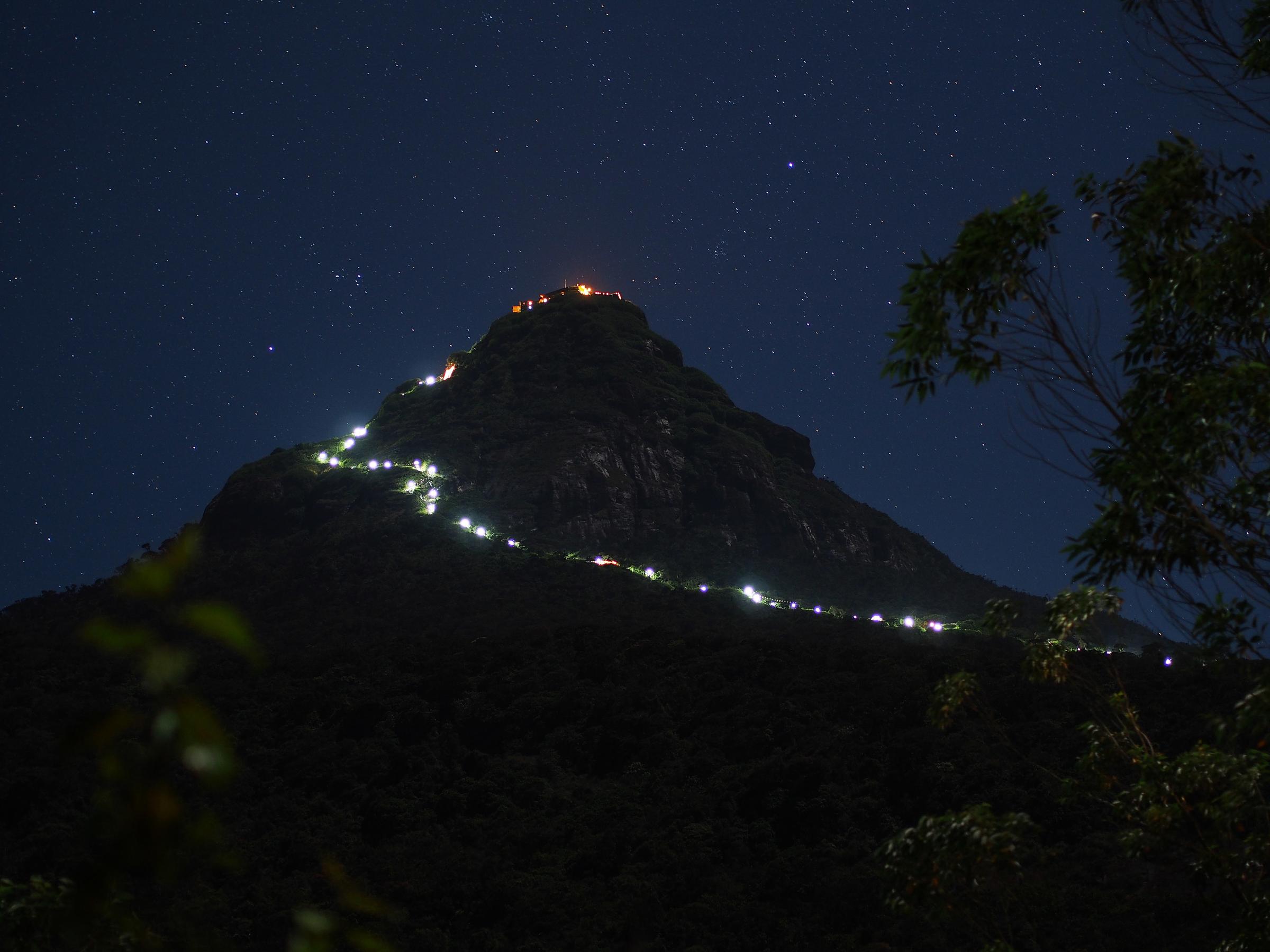THE ASCENT OF FAITH TO SRI LANKA’S HOLY MOUNTAIN

The over 2200m tall Adam’s Peak, located in the southwestern reaches of the Central Highlands in the Ratnapura district of the Sabaragamuwa province, is of equal significance to all the four major religions in the world. Over the centuries this historic mountain has served as a symbol of unity among the Buddhists, Hindus, Muslims and Christians as they have scaled the mountain to pay homage to a giant human “footmark” embedded on a rock on its pyramidal peak. Conforming to the pandemic guidelines, the season of pilgrimage of the Sri Lankan Buddhists up to the summit to venerate the footprint which they call “Sri Pada” (meaning “Sacred Footprint” in Sinhalese) commenced on the Full Moon (Poya) day of December falling on the 18th of this year and will continue until the Poya day of 15th May next year when the Buddhists celebrate the “Vesak” festival that marks the triple event of birth, enlightenment and death of Lord Buddha.
On reaching the summit of the Holy Mountain with its over 3000 steps carved into it, in a challenging effort needing mental will-power and physical stamina, the pilgrims huddle together, facing the east and adopting a posture of adoration, awaiting the sun to rise above the eastern horizon at any moment. They eagerly observe the changing radiant hues that light up the distant sky and when the upper rim of the sun ultimately appears, the pilgrims, going into ecstasy, cry out in an uproar: “Saadu, Saadu, Sa!”, meaning “it is good!”. Moving to the western side of the mountain, they now have the privilege of beholding another awe-inspiring sight in their entire lifetime: this conical peak begins to cast its triangular shadow on the surrounding plain right up to the hazy, far-off western horizon of the Indian Ocean of the early morning and with the sun rising higher, the shadow, gradually, begins to move backwards towards the mountain. This phenomenon is supposed to occur in only one other place in the world: the Grand Canyon carved by the Colorado River in Arizona in the United States.
The boulder at the peak of the mountain that soars majestically up to the clouds over the lush verdant jungle contains an indentation resembling a footprint which is attributed by Buddhists to the left foot of Buddha. According to Mahavamsa, the 5th century historical chronicle of Sri Lanka, written in the Pali language, the summit is hallowed by the footmark of Buddha which he left in his legendary sojourn in Kelaniya, on his third and final visit to the island at the request of god Maha Sumana or Saman, the chief guardian deity of the Sri Pada mountain and the hill country in general.
The Tamil Hindus regard the footprint as that of Lord Shiva, one of the principal deities of Hinduism. It is also fabled that this could be the legendary mount Trikuta (three-peaked mountain), the capital of Ravana, a mighty ruler of the island Lanka in ancient times and the chief antagonist in Ramayana, one of the two major Sanskrit epics of ancient India. Ravana abducted Rama’s wife Sita who was brought to his kingdom.
Muslim Arabs ascribe this solitary footmark to Adam, the first Ancestor, as he stood there for a thousand years of penance on one foot in the Garden of Eden for the sin he had committed. This belief gives credence to the notion that Sri Lanka could be the original Eden. Christians believe that it is the footprint of St. Thomas, one of the twelve apostles of Jesus, who preached in India. He is often regarded by the Indian Christians as the patron saint of their country.
Meanwhile, another version, albeit less known, exists as well. It relates to a 15th century Chinese work which says that the footprint was etched by Pwan-ko, the primordial man of Chinese mythology.
Ascending the summit
The summit can be reached by two different routes. The older route via Kuruwita in Ratnapura is thought to be more difficult and it passes through undulating hills, deep valleys and along the edge of precipices. This was the route taken by Marco Polo, the 13th century Venetian merchant and explorer, and Ibn Battuta, the 14th century Moroccan explorer. The more used path is the “Rajamawatha” (Royal Road) via Hatton which the early kings took to climb the mountain.
The trek to the peak takes about 5-6 hours and the ascent usually starts at nightfall to avoid the heat of the day and also to reach the summit at daybreak to view “Ira Sevaya”, that effulgent sunrise described at the beginning of this article. The trail is well illuminated and dotted with rest stations and small boutiques selling hot drinks and other refreshments to the pilgrims who are wearied with climbing. Customarily, the devotees take a bath at “Seetha Gangula” (Icy Stream) to cleanse themselves ritually prior to making votive offerings at the holy footprint. This is the parent stream of the 130 km long Kalu Ganga that empties into the Indian Ocean at Kalutara on the west coast. At “Indikatu Pahana” they hang a threaded needle on a shrub by the side of the trail in memory of Buddha having stopped at that place to mend a tear in his robe.
Located halfway up, the pilgrims come across a Peace Pagoda of significance, built in 1978 by a new Buddhist movement of Japan. At a sacred place, the devotees, ascending for the first time, tie coins in a white cloth as a tribute to the holy footprint.
It is also traditional for ascending and descending groups of pilgrims to exchange greetings and blessings of god Saman along the way. Old men and women, despite senility, are seen to climb the mountain, driven by the sheer power of faith, aided by walking sticks. When the pilgrims reach the summit, climbing “Mahagiridambe”, the extremely steep final stage of the ascent, a gong is rung, one toll for each visit. “Dolosmahe Pahana” (Twelve Months’ Lamp) is a massive brass lamp seen at the summit, which burns throughout the day and night. It is an offering made by King Virawickrama in 1542. Rain water taken from the footprint is said to have miraculous healing properties.

Early history
However, long before the advent of the four religions, the mountain was revered by the Veddas, the aboriginal inhabitants of Sri Lanka. The peak was associated with the abode of god Saman who was one of the four tutelary deities of Sri Lanka. After the arrival of Buddhism in the island around 246 B. C. the Buddhists made this local mountain god the guardian of their land and religion. But some say that “Samanala Kanda” or “Butterfly Mountain”, the other name used for the mountain by the Sinhalese, may owe its name to the myriads of small butterflies that fly from all over the country, forming themselves into a chain, to die upon the sacred mountain.
Rajavaliya, the chronicle of Sinhalese kings, records that King Valagamba (1st century B. C.) had sought refuge in the forest wilderness of Adam’s Peak against invaders from South India and later returned to Anuradhapura, the first royal capital. Hence, the discovery of the footprint is attributed to this king in exile. Then Mahavamsa mentions the visit of King Vijayabahu I (1058-1114) to the mountain.
Greek geographer and astronomer Claudius Ptolemy (100-170 AD) is the first westerner to make mention of this holy mountain with its footmark.
Around 1348 Giovanni da Marignolli, a European monk, traveller and the legate of Pope Clement VI to China, climbed Adam’s Peak. He wrote that it was a pinnacle of surpassing height which, due to clouds, could hardly be seen. The Catholic monk said that some thought that Paradise existed there.
The first Englishman to climb the mountain was Lieutenant William Malcolm via Ratnapura in 1815. John Davy, brother of the famous chemist Sir Humphry Davy, inventor of Davy Lamp, scaled the peak in 1817. He recorded the existence of an oversized footprint carved in stone.
Topographical features and legends
The pyramidal shape of the peak that dwarfs the other mountains in the area can be clearly visible from afar if it is not hidden by clouds. Much of the dense forest surrounding Adam’s Peak that forms a salient feature of the mountainous landscape, makes up the Peak Wilderness Sanctuary which is a cool misty forest similar to that found in the lower reaches of the Himalayas. The Arabs believed that the famous sweet Sri Lankan spices grew from cuttings and seeds that Adam brought with him from Paradise.
One of the best gem mines in the world are found in the region extending to the south and east from the foothills of the mountain. Legends abound with regard to the origin of these gemstones: ruby, topaz, aquamarine, garnet, cat’s eye, alexandrite, sapphire, etc. Again the Arabs believed that these gems were the crystallised tears of Adam and Eve when they were expelled from Paradise. According to Chinese folklore, when Buddha came to Sri Lanka he noted that theft was rife among the inhabitants due to poverty. To make them virtuous he sprinkled the island with sweet dew which crystallised into gems, thus giving the people a commodity to trade with to eliminate their poverty.
Alexander the Great on Adam’s Peak?
It is believed that Alexander the Great (356-323 BC), king of the ancient Greek kingdom of Macedon and one of the greatest military commanders of all time, visited the island after his military campaigns in the Indian subcontinent and ascended the sacred mountain. A 15th century Persian poem, celebrating his exploits, says that he fixed chains with rings and rivets made of iron and brass to enable travellers to climb the mountain to find the “sepulchre of Adam”. But there is no evidence to prove that Alexander made it this far to the south during his Asian forays. The chains in question were probably placed there by an early Sinhalese king and replaced over the centuries.
Climbing out of season
Although off-season trekking is not advisable at all, a few adventurous foreign tourists and local youths prefer to do this for fun or for exploratory purposes. From May to December the sanctuary is pounded by heavy and unpredictable rains that may continue for days unabated, often accompanied with thunder and lightning, sometimes inundating all the paths leading up to the summit that is now shrouded in mist. Strong winds gusting through the forest break branches of trees, obstructing the pathway. The cutting off of the current along the trail plunges the whole area into darkness and all stalls and boutiques remain closed. It is said that leopards, in quest of food, roam over the area, even reaching the village of Nallathanniya at the foot of the mountain where the steps begin. Rumour has it that during this period a herd of thirteen dwarf elephants from the neighbouring forests climb the mountain to reach the summit. According to folklore, god Saman and other deities avail themselves of this off-season not only to pay respect to the sacred footprint but also to clean up the area, collecting litter left by the pilgrims in the preceding six months.
Years back, according to the itinerary provided by a travel agency, I had to venture on this hazardous undertaking of an off-season ascent of Adam’s Peak with a newly-wedded young couple from Spain. An experienced local guide from the village was hired for our safety on the way. We were asked to sleep a few hours beforehand and eat a light meal. The trekking started around 2 a. m. and it was easier, as instructed by him, to climb the steps by walking across them in a diagonal pattern and climb at one’s own pace. A group of Russian tourists had already reached the summit before us to view the sunrise. We were relieved when the lay caretaker who had taken up residence atop the summit generously offered us a hot cup of coffee in that early morning which was so chilly up the mountain. Fortunately for us, we did not face any untoward incidents throughout the trekking except for the case of a herd of wild boars that followed us menacingly for a few meters when we started climbing, but were chased away later by the guide. On our way down, being on the heights of the mountain, we felt wobbly on our knees. ***





